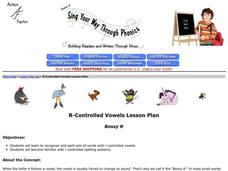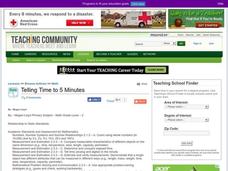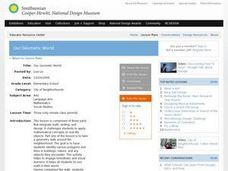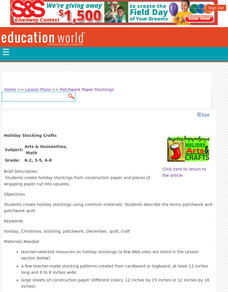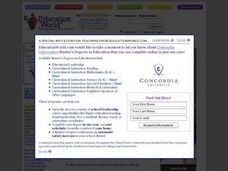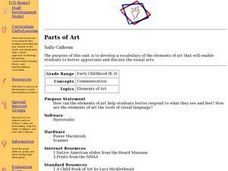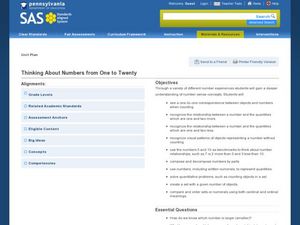Oglebay Institute
Post-Impressionism: Pointillism
How can little dots in two colors make a third color? Experiment with pointillism and color mixing with a series of activities. After viewing paintings by Seurat and watching a teacher demonstration, pupils create samples of three...
Curated OER
Sing Your Way Through Phonics Lesson Plan
Students recognize and spell sets of words with r-controlled vowels. They become familiar with r-controlled spelling patterns.
Curated OER
Telling Time to 5 Minutes
In this second grade lesson your class will practice telling time. The goal is to tell time to five minutes using an analog clock. Your young students count by 5 minute intervals and discuss elapsed time.
Curated OER
Food Pyramid Abacus
Students investigate the Food Pyramid by constructing a creative project known as a Food Pyramid Abacus. They correlate the color beads withe each food group and the number of recommended servings from each. The abacus is a learning tool...
Curated OER
Life Comes in Cycles
Kids are fascinated by chickens and their eggs. Here is a learning exercise has young learners take a look at the four stages in a chicken's life cycle. They have four cycles to organize: egg, chick, young bird, and adult. They have to...
Curated OER
Our Geometic World
Students walk around the neighborhood and identify various polygons and lines in buildings, nature and other objects. They design a building using various geometric patterns, shapes and lines. Students complete a descriptive writing of...
Curated OER
Patchwork Paper Stockings
Youngsters create holiday stockings from construction paper and pieces of wrapping paper cut into squares. It's always nice to have a holiday craft, or two, up your sleeve during December. This craft is easy to implement, and the...
Curated OER
Making a Pinhole Camera
Students are introduced to the basic straight line pattern of travel that light takes. A cereal box and wax paper provide the pinhole camera that captures the light's inverted image. Shifting this pattern provides additional challenges.
Curated OER
Ice Cream
Help your children discover the verbal ostinato pattern of a rhyme. Learners sing a rhyme about ice cream, practice it several times, then divide into groups to sing the rhyme analyzing the patterns and rhythm.
Curated OER
Autumn Colors Shine Through
Students create colorful stained-glass Autumn window decorations. They shave crayons with scissors, melt the crayons in wax paper with an iron, and cut out a leaf pattern to display on windows.
Curated OER
Parts of Art
Young scholars define and use new vocabulary associated with the elements of art. As a class, they brainstorm different ways in which we communicate with one another. In groups, they view different pieces of art from the Native American...
Curated OER
High Frequency and Spelling Words
Four high frequency word activities are to be found on this set of simple worksheets. Each activity is to be completed on a different day and each focuses on the /qu/ and /wh/ spelling pattern. Learners will write sentences, circle words...
Curated OER
This Land is Your Land Shaker Routine
Shake it up! Give each dancer two hand-held shakers of any kind. If your class doesn't have any shakers, do a project and make your own. Small containers with lids, some rice or dried beans, and glue or tape to seal the lids shut. Teach...
Curated OER
Masks of Africa
Students explain the purpose of masks to various cultures in Africa. They recognize the conceptual patterns used to create African masks and illustrate their understanding by creating their own masks
Curated OER
How Many Feet Will We Meet?
Emerging speakers distinguish between the sounds for short vowel /e/ and long vowel /e/. They are introduced to the vowel patterns that comprise the long vowel sounds, with emphasis on /ee/. They practice reading and spelling a variety...
Curated OER
Fluency: Read Regular Words
Second graders engage in a timed choral reading activity to practice reading with accuracy and fluency. The teacher starts the timer and taps a reading rhythm on the desk as the class reads a series of words in unison. When the time is...
Curated OER
Fluency Instructional Routine: Read Regular Words
How many words can you read in one minute? Practice reading fluency, speed, and accuracy with this scaffolded lesson plan. This offers a full script if you need it, however it can also be utilized as an outline. Demonstrate the activity...
Pennsylvania Department of Education
Thinking About Numbers from 1 to 20
Help your kindergarteners discover new number-sense concepts and to compose and decompose numbers. Though the resource contains no procedural details, the assessment tool (which you can find in the "printer friendly version") has...
Curated OER
Relate Counting to Addition and Subtraction
Use patterns to practice basic addition; pupils count by two, starting from eight and counting on to 20. They record the five numbers missing from the sequence. Below, the worksheet walks learners through the process...
Curated OER
Decomposing Numbers Step-By-Step
Here are two addition-related exercises. However, bear in mind, the explanations are featured below each of them. Use this as an all-class warm up, revealing the explanations if and when you see fit. First, examine the four sets of...
Curated OER
Tissue Paper Butterfly
Creating butterfly art is as simple as 1-2-3. Kids cut coffee filters into butterfly shapes. Next, they wet and place squares of tissue paper onto the filters. Fifteen minutes later, they lift the tissue to reveal a colorful pattern...
Curated OER
Dinosaurs
Students are introduced to the various types of dinosaurs and write in their journals about their favorite one. After listening to a story and watching a filmstrip, they color a few pages in their Dinosaur Friends Book. They also examine...
Curated OER
Bee a Reader
Use a fun tongue twister to help your class remember the /ee/ sound! With this lesson, they distinguish between the sounds for short vowel e and long vowel e. They are introduced to the vowel patterns that comprise long vowel sounds,...
Curated OER
Talking About Your Name in Math Terms
Add imagination and creativity to your math lesson plan. Young mathematicians investigate ways to express their names in mathematical terms. For instance, they can count the number of letters, analyze the geometric shapes of the letters,...
Other popular searches
- Geometric Number Patterns
- Extending Number Patterns
- Fibonacci Number Patterns
- Math Number Patterns
- Number Patterns Worksheets
- Odd and Even Number Patterns
- Number Patterns in Math
- Ab Number Patterns
- Looking for Number Patterns
- Recognizing Number Patterns
- Number Patterns and Sequences
- Patterns Hundred Chart

